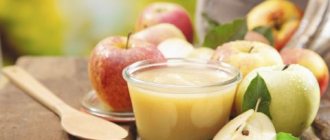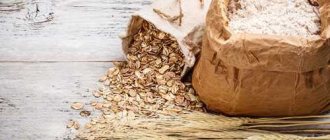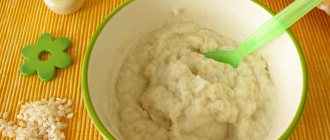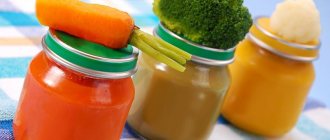It's hard to imagine any lunch without potatoes. This versatile vegetable is added to various dishes. On many tables, potatoes are served daily. The puree from this vegetable has a pleasant taste, ideal consistency and is famous for its ease of preparation. This is why many mothers rush to introduce mashed potatoes into complementary foods. In fact, there is no need to rush into introducing this vegetable into complementary foods. Let's look at how many months you can give your baby mashed potatoes.
Potatoes should appear on a child’s menu in the first year of life. Kids eat mashed potatoes with pleasure and even ask for more. In most cases, potatoes do not cause allergies in children. But there are some points that should be considered before giving puree to your baby.
This vegetable contains few vitamins, but this does not mean that it is unhealthful:
- Potatoes contain a lot of carbohydrates, which produce energy for the body to function.
- Potatoes are also high in protein. Protein, in turn, consists of amino acids, which are the building materials for cells.
- Among the vitamins, potatoes contain a lot of ascorbic acid, which strengthens the immune system. Selenium is needed for normal thyroid function. Potatoes are also rich in potassium.
- Potatoes contain a lot of fiber, which is good for intestinal function. Regular consumption of this vegetable helps eliminate waste and toxins from the body.
Disadvantages of Potatoes
Along with its beneficial properties, potatoes also contain something that can harm a small child:
- The starch that tubers are so rich in makes potatoes a “heavy” product for the baby’s digestive system. The baby will begin to produce enzymes capable of completely digesting potato starch only by 9-10 months of age. In addition, it can cause allergies in the baby. By the way, an allergic reaction to potatoes is a rare case. But you should still be careful and know exactly at what month it is better to start potato complementary feeding.
- Some children have problems with bowel movements such as constipation after eating potatoes.
- Excessive consumption of potatoes will certainly contribute to excess weight gain. Therefore, those who have a tendency towards obesity and excess weight should include potatoes in the menu to a minimum.
- For some guys, potato dishes cause increased gas formation and bloating.
At what age can children be given mashed potatoes?
So, when should you introduce potatoes into complementary foods? The recommended age for the first feeding of mashed potatoes is 6.5 – 7 months of a child’s life. Formula-fed children become familiar with potatoes somewhat earlier than infants. Potatoes are not the first vegetable in a baby’s diet. Before this, the baby had already tasted pureed zucchini, cauliflower and pumpkin.
However, according to Dr. Komarovsky, potatoes should be introduced into infant feeding no earlier than 8 months, starting with potato broth, gradually moving to thin purees and soups. A well-known pediatrician believes that potatoes can be given to a baby after porridge and fermented milk products have already been introduced into complementary foods.
Like other new products, potatoes for babies should be cooked in water, without adding salt, milk (even if it is breast milk), or butter. For the very first time, the baby should try 0.5 teaspoon of puree. During the day, the mother carefully monitors whether the baby has an allergy, constipation, or other undesirable reaction to potatoes. If everything went well, then next time the baby is given 1 teaspoon of puree. The portion can be increased each time. Mashed potatoes can be given to children 2-3 times a week. Subsequently, it will be possible to combine potatoes with other vegetables or add breast milk to it.
If after the first feeding the baby has any reaction (rash, tummy pain, constipation, restless sleep, etc.), then this dish should be canceled and not given to the child for some time.
Tips for parents on how to introduce potatoes for complementary feeding:
- Mashed potatoes for children should have a liquid consistency and be warm.
- Give your baby only fresh puree.
- Potatoes for baby feeding can be boiled on the stove, in a double boiler, slow cooker, or baked in the oven with their skins on.
- If you cook the tubers in their uniforms, they will retain much more nutrients and vitamins. Unfortunately, the taste of the potatoes will suffer. The tuber, boiled in its skin, needs to be peeled, chopped and diluted with boiled water.
- It is best to mash potatoes manually, because... After using a blender, there will be a lot of gluten in the puree.
- Soaking potatoes in water before cooking will get rid of nitrates in the tubers, as well as excess starch. In this case, the potatoes will lose some of their vitamins, but the risk of allergies will be minimized. How long should you soak potatoes for a child? You need to keep the vegetable in cold water for 2-3 hours.
- Potatoes don't go well with meat. Combine it better with other vegetables or fish.
- Under no circumstances should you cook green potatoes for children. It contains a dangerous substance - solanine, which is poisonous to the body.
- Do not give your baby potato dishes more than 2-3 times a week.
- When peeling tubers, remember that the bulk of the vitamins are concentrated just under the skin. Remove the peel in a thin layer. The opposite should be done with old potatoes: there the layer of peeled peel should be thick.
- You can add salt to potatoes and other dishes after 11-12 months of the baby’s life.
The best potatoes for a child are those grown in your own garden without adding chemical fertilizers. Unfortunately, not everyone has the opportunity to grow vegetables at home. In this case, you have to be extremely careful when buying vegetables in a store or market. When buying potatoes, you should pay attention to:
- Tuber size. It is best to buy a medium-sized vegetable.
- Wateriness. When there is a lot of water in the tubers, this indicates a large amount of nitrates in the fruit. To check, you can cut the tuber or pierce it with a toothpick. If water leaks through the hole, it means the vegetable is full of nitrates.
- Manufacturer. It is desirable that the potatoes be locally produced, and not brought “from abroad”.
- Stock up on potatoes during the harvest season, so you will be protected from buying genetically modified vegetables.
Selection of vegetables for puree and pre-processing
All parents want only the best for their baby, and this also applies to food. There are several rules for choosing potatoes for baby feeding.
- The root crop must be of domestic production. Ideally, you (or your relatives) grow it in your garden.
- It is better to buy potatoes in season, this reduces the likelihood of buying GMO products, as well as vegetables treated with chemicals.
- Give preference to medium-sized potatoes - they have more useful properties than small and large tubers.
- Do not make mashed potatoes for babies from greenish potatoes.
- You should not feed your baby potatoes with wrinkled skins, a whitish coating, or rotten barrels. The tuber should be smooth, hard, with an even skin.
- Pierce the potato. If juice starts to come out from the puncture site, it is better not to give such potatoes to the baby, as they contain a lot of nitrates.
Having chosen a natural, high-quality root vegetable, you can begin preparing complementary foods. At first glance, there is nothing complicated about this - boil the potatoes, mash them and give them to the child. But it's not that simple. Potatoes must first be freed from starch and nitrates.
- Remove the peel with a knife. Don't try to remove it in a thin layer. The more you cut, the better.
- Fill the tuber with water and leave for a day. This is necessary to remove excess starch and nitrates.
- Before cooking, cut the root vegetable into cubes.
Helpful: How much milk should a newborn eat per day?
Let's sum it up
When can you give mashed potatoes to your baby? Potatoes can be introduced into complementary foods from 6.5 to 7 months. Potatoes are not considered the healthiest vegetable, but they allow you to diversify your baby's menu. Potatoes rarely cause allergies, but can cause constipation and bloating. For the very first times, potatoes for complementary feeding should be cooked in water and without adding any ingredients.
“In Rus', without potatoes, it’s like a holiday without an accordion,” people say. The earthen apple has taken root on our table. This is an inexpensive vegetable that quickly saturates the body. It rarely provokes allergies, is rich in potassium, phosphorus and vitamin C, which is why it appears on the baby’s menu in the first year of life. But potatoes also raise a number of concerns: there are disputes about the timing of complementary feeding, negative reactions, and even how to properly prepare mashed potatoes for babies.
Potatoes are primarily made up of carbohydrates, making them the most calorie-dense of vegetables. People prone to obesity are advised to limit this product. But if there are no problems with weight, then the vegetable should definitely be included in the diet.
Potatoes normalize water balance, improve metabolism and remove toxins from the body. The product contains 11 types of vitamins. It contains a record amount of potassium, which normalizes the functioning of the cardiovascular system.
About the benefits of potato dishes
There are a number of reasons why you should not give up the children's potato menu. Hypoallergenicity comes first: cases of potato allergy in a child are rare. If such a reaction occurs, it is most often caused by the starch contained in potatoes. Then it is recommended to soak the vegetable before cooking. How else are potatoes good for your baby?
- Powerful energy drink. A serving of baby mashed potatoes “covers” 1/10 of the energy needs of a growing body.
- An accessible source of nutrients. Potatoes are available all year round. Its price is not very affordable, but one serving of the product contains a fifth of the daily dose of minerals a baby needs. If the potatoes are young, then along with them the child will immediately receive half of the required amount of ascorbic acid, which strengthens and is a strong antioxidant. The same amount will be given by potatoes and rutin, which strengthens capillaries and increases the body’s resistance to infections. And the trace element selenium, which potatoes, unlike many vegetables, can boast of, will help improve the functioning of the thyroid gland.
- Assistant for the gastrointestinal tract. Due to the high content of fiber and minerals, potatoes are able to cleanse the body of toxic substances and stimulate the functioning of the intestines and stomach. When consuming this vegetable, the risk of reproduction in the gastrointestinal tract is reduced.
- Protein supplier. Potato protein is similar to animal proteins and contains amino acids necessary for the formation of protein in the human body and the construction of cells.
Potatoes also contain folic acid, which is important for the formation of the central nervous system and brain development. And potato starch lowers cholesterol levels.
Product composition in the table
The table below shows an analysis of the basic composition of potatoes, how many useful substances are contained in 100 grams of peeled product.
Table - Chemical composition of potatoes
| Substance | Quantity per 100 g |
| The nutritional value | |
| Squirrels | 2 g |
| Fats | 0.4 g |
| Carbohydrates | 16.3 g |
| Macro- and microelements | |
| Calcium | 10 mg |
| Magnesium | 23 mg |
| Sodium | 5 mg |
| Potassium | 568 mg |
| Phosphorus | 58 mg |
| Chlorine | 58 mg |
| Sulfur | 32 mg |
| Iron | 0.9 mg |
| Zinc | 0.36 mg |
| Iodine | 5 mcg |
| Copper | 140 mcg |
| Manganese | 0.17 mcg |
| Selenium | 0.3 mcg |
| Chromium | 10 mcg |
| Fluorine | 30 mcg |
| Vitamins | |
| PP | 1.8 mg |
| Beta carotene | 0.02 mg |
| A | 3 mcg |
| IN 1 | 0.12 mg |
| AT 2 | 0.07 mg |
| B5 | 0.03 mg |
| B6 | 0.3 mg |
| B9 (folic acid) | 8 mcg |
| WITH | 20 mg |
| E | 0.1 mg |
| H | 0.1 mcg |
Vegetable as medicine
Potatoes, juice and decoctions based on them are used in traditional medicine recipes. In what cases can a vegetable exhibit healing properties?
- Diseases of the digestive system. Potato juice, boiled vegetables or potatoes from the oven can be prescribed for ulcers, gastritis, and liver problems. In these cases, the product is able to relieve inflammation and create a protective shell.
- Kidney diseases. Due to the high potassium content, potatoes help remove excess fluid from the body.
- Bronchitis, colds. By inhaling potato vapor through an inhaler, you can recharge your body with natural antiseptics. And by applying hot tubers to your nose or chest, you will improve blood circulation in the affected organs.
- Headache . Juice squeezed from potatoes has an antispasmodic effect.
- Burns. Grated raw potatoes applied to the affected areas of the skin help heal wounds from thermal injuries.
When potatoes are poison
However, in some cases, potatoes can actually have a negative effect on the child’s body. This is due to the large amount of carbohydrates, the variety of substances in the composition and the ability of the product to change properties depending on the timing and storage conditions. What risks are most often discussed?
- . Over time, the substance solanine is formed in potatoes - a poisonous alkaloid that can destroy red blood cells and the nervous system. An overdose is fatal to humans. A clear sign of the presence of this toxin is the green tint of the product. Solanine accumulates under the skin and in the sprouts, so giving old, sprouted potatoes to children is strictly prohibited.
- . There are cases when, when potatoes are introduced into the baby, the baby begins to experience difficulties with bowel movements. Starch, contained in large quantities in the product, can suppress intestinal motility. To avoid this effect, the vegetable should be added to the menu after the child has mastered foods that stimulate the elimination process.
- Overweight . Due to its high calorie content, the product, if eaten in large quantities and constantly, can cause rapid weight gain. Therefore, pediatricians recommend a menu with limited potato content for obese children.
The vegetable is definitely useful, but if introduced incorrectly into complementary foods and overeating, it can put an unjustified burden on the child’s body. So from what months will its appearance in the diet be appropriate? Pediatricians recommend starting to introduce your baby to potatoes no earlier than six months.
When to introduce into complementary foods
The time when you can introduce potatoes into complementary foods without risk to health comes after the child has tried and. Moreover, potatoes should not be the first vegetable on the baby’s table. First they recommend onions. It turns out that artificial farmers come to potatoes faster - approximately . But children who eat , will receive the first half spoon of mashed potatoes a month and a half later.
Usually, potatoes and other vegetables are given to children at feeding time, which is close to 14:00. In the first weeks, it is better to prepare fresh puree before each meal; for older children, the product should be stored in the refrigerator for two days. The volume of the daily portion is increased to 130-150 g by the year.
Three signs that the tubers are good
It’s good if the baby eats potatoes from his own garden. Then you know exactly what was fertilized and how the fruits were processed. If this is not possible, then consider a few tips when buying vegetables at the market or supermarket. There are three signs by which you can visually determine the quality of potatoes.
- Color . The fruits must be uniform in color, without spots or green spots.
- Size . Potatoes that are too large should alert you. For a child, it is better to take a vegetable of small and medium size, imperfect in shape, but without sprouts.
- Wateriness. The presence of watery discharge is a sign that the tubers were treated with nitrates. Select any potato from the box and ask the seller to cut it. This will allow you to assess the internal state of the fetus and, by pressing, determine the amount of moisture.
It is better to purchase potatoes grown in your region. Directly tell the seller that you need a vegetable to feed your baby. As a rule, in this case, conscience prevails over the desire for profit, and a truly normal product is recommended.
Cooking features
If potatoes appear on the adult table fried or with the addition of butter, then when preparing them for children, such culinary turns are strictly taboo. At the beginning of complementary feeding, pediatricians recommend a static and simple recipe for mashed potatoes for infants.
So, potatoes should be peeled from their “jackets” and cooked in a steam bath without salt. The finished vegetable is crushed with a blender. Very often, children do not like the taste of this fruit at first, so to “sweeten the pill” you can add breast milk or formula to the puree, as well as a few drops of refined vegetable oil. As a rule, they begin adding salt to potatoes and other savory dishes after 10-12 months.
Other recipe
But reviews and experiences of experienced mothers open up other options for preparing potatoes for the baby. Parents of children prone to allergies must soak the vegetable in water before cooking to get rid of starch. Some people first grate the potatoes, squeeze out excess moisture, and only then heat treat them, for example, in a slow cooker.
More courageous parents give potatoes in combination with other vegetables and even meat, after the latter appears on the child’s menu. At the same time, a number of nutritionists do not recommend potatoes as a side dish for meat products: the combination of these dishes puts a strain on the stomach and contributes to the formation of “bad” fat.
Cooking rules
Whatever method of cooking potatoes you choose, you should follow the general rules for processing tubers before cooking.
- The washing up . Before peeling, potatoes should always be pre-washed under running water. There should be no dirt when it comes to feeding a child.
- Peeling. In old potatoes, the layer that you cut off when peeling should be thick. Don’t skimp on the product—it’s important to exclude even the slightest possibility of harmful substances that may be contained under the skin getting into your baby’s plate.
- Cooking. Good potatoes take no more than 20 minutes to cook. You need to lower the vegetable into boiling water.
The older the child gets, the more potato dishes you can offer him. Steamed potato pancakes, pancakes, boiled with herbs and baked potatoes, pureed soups, dumplings. The ban on eating fried foods lasts until at least three years of age. French fries and chips are generally beyond discussion.
At what age and how to introduce potatoes into your baby’s complementary foods, of course, the observing pediatrician should say. If the baby is healthy, this will most likely happen around the equator of the first year of life. After adapting to a new product, you don’t need to feed your baby powder to celebrate. Ask your doctor how much vegetables will be good for you. Depending on the rate of weight gain of the baby and its physiological characteristics, the doctor will recommend suitable dosages and food combinations.
The baby’s body begins to change with the introduction of the first complementary foods into his diet. The child is actively gaining weight, bone growth is increasing, and the gastrointestinal tract is learning to digest new foods. Vegetables and fruits enrich the body with vitamins and minerals. In addition to zucchini, broccoli, cauliflower and pumpkin, children's menus include mashed potatoes. In the Daughters-Sons online store you can find one- and two-component products for babies. Vegetable purees with fish and meat, such as potatoes and pink salmon, are very popular.
How to prepare “Mashed Potatoes for Weaning”
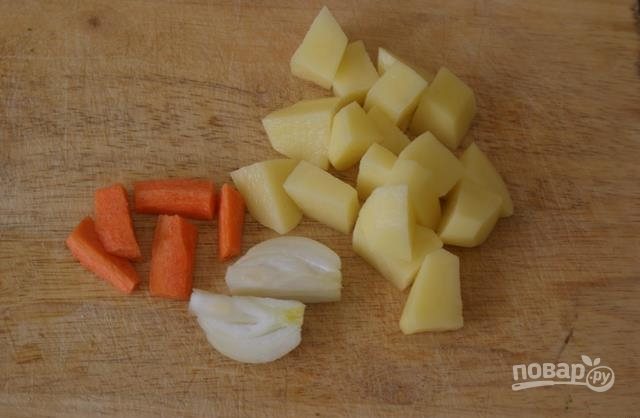
Peel, rinse and chop the potatoes, carrots and onions.
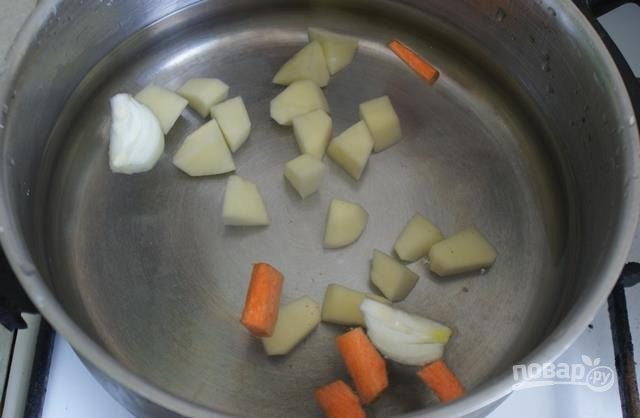
Let these vegetables boil in a liter of water.
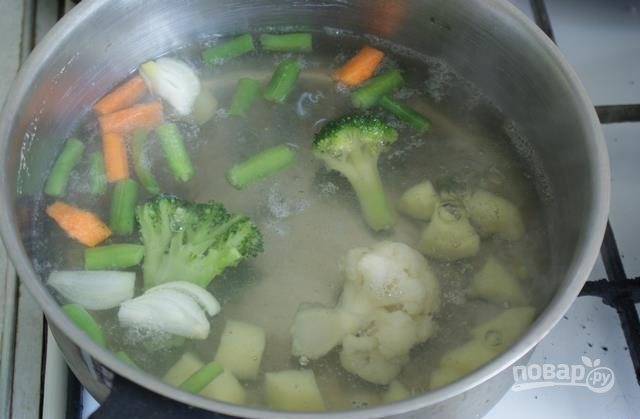
After boiling, add broccoli, cauliflower and beans in pieces to the water. Cook vegetables for 7 minutes.
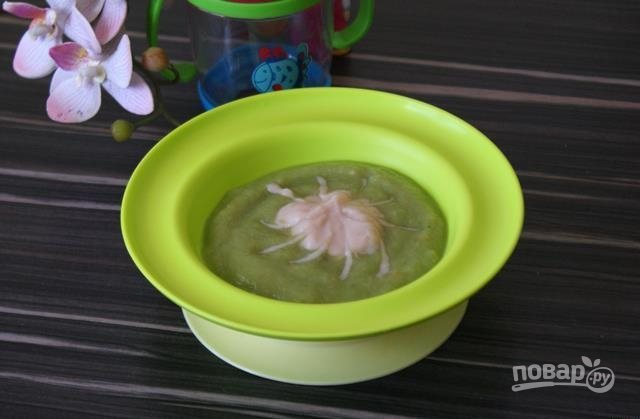
Grind the prepared vegetables into a puree with a blender, adding the required amount of broth and oil. Can be served with meat puree.
At what age should potatoes be introduced into the menu?
For a child's nutrition, potatoes are a neutral product - they do not have any special beneficial properties, the vegetable contains a lot of starch and carbohydrates. Almost all kids love well-whipped, fluffy mashed potatoes. Pediatricians name different dates for introducing this dish into the menu. Dr. E. Komarovsky recommends giving it after the child’s first tooth appears, at about 8 months.
When choosing root vegetables and preparing them, you should pay attention to:
- appearance - the vegetable should be of medium size, the skin should be free of rot, dents and white coating. Homemade potato tubers would be ideal;
- preparation before heat treatment - well-peeled potatoes must be soaked in cold water for a day to get rid of starch;
- Cooking time – depends on the cooking method. If you decide to boil the potatoes, the optimal cooking time is about 25 minutes after boiling. During this time, the root vegetable will boil well, absorbing more water.
If you introduce potatoes in their pure form, they can cause constipation. Therefore, it is worth starting with two-component dishes, for example, zucchini and potatoes. If your baby suffers from diarrhea, then mashed potatoes will help normalize his condition.
Important!
Complementary feeding made from mashed potatoes, which includes potatoes, can be introduced from 5-6 months. The baby will be able to try the one-component option only at the age of 8 months. You can add a little breast milk to the finished dish.
conclusions
Complementary feeding with mashed potatoes should be introduced in combination with other vegetables. In its pure form, the root vegetable is given to children after 8 months. Puree goes well with meat and fish. It is very satisfying and all kids, without exception, like it. In our online store you can choose ready-made vegetable dishes with veal, chicken, rabbit and fish.
Many people love potato dishes, and even a child can cook potatoes. But can a baby have mashed potatoes? Many mothers ask this question and try to start feeding their children correctly and in the most healthy way. Let's figure out when, how and at how many months you can start feeding your baby mashed potatoes.
At what age can you give mashed potatoes to an infant + recipe
Young, inexperienced mothers are very worried when it is time to give their baby complementary foods.
Food should be healthy and of high quality, since the child’s taste preferences in the future depend on this.
Despite the fact that the best food for a baby is mother's milk, in some situations it can be replaced by formula. From solid food, mashed potatoes are very useful for babies. It is soft and tasty.
- 1 Information
- 2 Age
- 3 How to introduce it into the diet
- 4 How to choose
- 5 Tips
Information
Both children and parents like potato dishes. It is not surprising that many children begin to use it at a very early age. .
Potatoes are available, easy to buy or grow on your own plot. But it is important for a young mother to know from how many months this complementary food can be given to her baby.
It is also important to cook potatoes correctly, choosing only fresh young fruits. Otherwise, an allergy may occur.
Positive properties of potatoes. Why is this product recommended for young children?
- Effect on the digestive as well as nervous system. The root vegetable is rich in iodine, potassium, iron, and phosphorus. Potatoes contain vitamins and minerals that are beneficial and necessary for a growing body. To preserve them, you need to properly prepare the product.
- Pleasant taste. Potatoes are never too salty or sweet. The taste of mashed potatoes is unobtrusive and light, which is what children like so much. This complementary food is suitable for an infant: it does not cause irritation. It is better to prepare mashed potatoes, but baked potatoes will also work.
There are also disadvantages. They can be avoided if you choose good fruits and monitor the child’s reaction.
- Allergies may occur because the tubers are rich in starch. Therefore, you need to monitor the reaction of children: this is especially true for the first feeding. Giving and preparing mashed potatoes for babies should be done carefully. If the baby becomes ill, nausea, vomiting, weakness appear, complementary feeding should be stopped and consult a doctor. Allergies in infants are more severe and the help of a doctor is always required.
- Only light young fruits without spots are suitable for complementary feeding. Green spots are dangerous: they can poison the baby with solanine. Mom should carefully choose potatoes to prepare complementary foods. Tubers grown on your own plot are useful, but they also need to be inspected: they can be damaged by worms.
Age
At what age (in months) can a baby be given mashed potatoes? How old should the baby be? What is the best way to do this and how to prepare puree? At what age can you safely introduce it into your diet? These questions concern inexperienced mothers. There is a general opinion, but it is better to consult a doctor, since all cases are individual.
For babies who received only breast milk, potatoes are introduced into complementary foods from 6 months. If the baby is artificially fed, the first complementary feeding can be started at 5 months, but it is better not to rush and wait until six months.
Along with this product, other vegetables can be introduced into complementary foods: zucchini, cabbage. But this must be done carefully: allergies in 6-month-old babies occur due to the wrong combination of foods. It is better to consult a pediatrician about everything. You should also carefully monitor the child’s reaction: his condition, mood, stool.
Some doctors say that potatoes should be introduced into complementary foods after fermented milk products and cereals. The baby's digestive system will get used to pureed foods, so it will be easier to digest the vegetable. You can first prepare the decoction, and only then move on to the puree. In this way, eating disorders will be avoided and allergies will not occur.
How to introduce it into your diet
How many months should a baby be? A new dish should be given to a baby from 6 months old carefully and gradually. You can just give it a sniff at first, and then treat it with a teaspoon of puree.
If the baby reacted normally, next time you can increase the portion. The child should have good stool and there should be no discomfort.
Therefore, after the first feeding you need to wait for some time.
If the mother notices bad signs in the child’s mood or condition, complementary feeding should be postponed. Perhaps mom just couldn't cook the potatoes properly. When your baby develops an allergy, you should postpone such feeding or even consult a doctor.
You definitely shouldn’t give puree before 5 months. At this age, the baby’s body is not yet accustomed to such food. Experienced mothers advise mixing breast milk with mashed potatoes first. This will make it easier to digest.
How to choose
If an adult can eat any tubers, then with baby food everything is different. A baby at 6 months should be given food prepared from new potatoes as complementary foods. Vegetables should be small and juicy. There should be no damage, stains or plaque. It is strictly forbidden to use and prepare puree from tubers damaged by insects.
Tubers from your own garden are most suitable. You need to be careful when buying store-bought ones: they often contain chemicals for growth and storage. Potatoes grown in your own garden are more beneficial, especially for a child.
There is also canned food. When mom cannot determine the quality of a purchased product, you can buy a canned one. For very small children, you can prepare one-component puree that does not contain salt, cream, sugar, or additives.
When a mother decides to prepare puree herself and give it to her baby, she should not add anything other than water to the dish. Potatoes and plain water are the best ingredients for baby food. This can be the first complementary food. The recipe according to which the potato tubers were prepared also matters. They just need to be baked or boiled.
What recipe should I use to make the most delicious and healthy puree? There are only two of them: bake and boil. Already prepared vegetables are crushed to the smallest state. Then add a little milk, preferably breast milk. This recipe is great for babies: tasty and satisfying.
There is a recipe for those who are bottle-fed: with the addition of baby formula. There is also a recipe with vegetable oil and cow's milk. But it is not suitable for the first feeding: it is better to give it to slightly older children. And for the first time it is better to use a recipe with breast milk.
You need to chop the potatoes as finely as possible. The mixture should not be very liquid, but there should not be any solid pieces. It is better to dilute the puree with mother’s milk, and gradually transfer the child to cow’s milk, otherwise an allergy will occur.
Adviсe
- Many mothers strive to preserve vitamins and often do not even finish cooking the potatoes. It is undesirable to give such a dish to a 6-month-old child as complementary food: not only can an allergy occur, but also poisoning can occur. It is necessary to soak the tubers in cold water before cooking. Some vitamins will be lost, but starch will not do any harm. How long to cook? Better longer.
- The first feeding of mashed potatoes occurs without salt and sugar. There should only be water and potatoes. The recipe with a salted dish is suitable for older children.
- There is no need to abuse such dishes. Potatoes are healthy and have a pleasant taste, but they contain starch: this substance can be harmful. You can give puree to your baby 2-3 times a week, but not more often. Otherwise, an allergy will occur.
- You need to prepare and give food to your baby right away. Even if it sits in the refrigerator, the beneficial properties are lost and the taste changes. They give the baby only fresh food that the mother has just prepared.
- It is better to grind the potatoes yourself, rather than in a blender. The latter forms gluten.
- It is recommended to boil potatoes in their skins, rather than peeled. Then the skin is removed and the tubers are crushed. You can also steam it.
Source: https://grudnichky.ru/pitanie/so-skolki-mesyatsev-kartofelnoe-pyure.html
Benefits and harms
Potatoes are a root vegetable that contains almost the highest amount of carbohydrates and starch than any other vegetable. Because of this, it is quite difficult for a child to digest, and can also cause. In addition, if you often feed your baby mashed potatoes, he may develop. Potatoes do not contain as many important and microelements as other vegetables, such as broccoli or.
And, nevertheless, you should not think that mashed potatoes are completely unhealthful. On the contrary, it is the best option for the former. Kids really love soft, neutral-tasting “puree”, they eat it willingly, and sometimes even ask for more.
Also among the beneficial properties of potatoes or mashed potatoes is the fact that this product has a beneficial effect on the cardiovascular and digestive systems. This root vegetable also contains essential amino acids, organic acids and antioxidants for the body.
Important!
Potatoes for mashing should in no case have green spots or any defects.
There is a risk of solanine poisoning the baby. Among microelements, the vegetable is rich in potassium, iron, phosphorus, and iodine. The main value of this product is that the protein content in it is very high and at the same time it is not inferior to its animal counterpart.
Description of preparation:
I want to offer you an option on how to prepare mashed potatoes for complementary feeding.
To get the maximum benefit, I also added other vegetables: broccoli, carrots, cauliflower, onions and beans. Do not add dairy products or butter under any circumstances. Replace it with olive oil. Purpose: For children / Up to one year Main ingredient: Vegetables / Broccoli / Potatoes Dish: Mashed potatoes Geography of cuisine: Russian cuisine Diet: Pregnant and lactating / Lenten dishes / Vegetarian food / Low-calorie / PP recipes
At what age can it be introduced into a baby’s diet and how?
Pediatricians are unanimous in their opinion as to how many months mashed potatoes will be beneficial for a baby.
The optimal age to start feeding mashed potatoes to babies who have been fed only breast milk is six months. Otherwise, namely, if special mixtures were added to the diet or the baby was completely on artificial food, then potatoes can be introduced as early as five months.
Typically, mashed potatoes are introduced along with cauliflower, zucchini and broccoli. These vegetables are the most healthy and hypoallergenic, and are also the easiest to digest in the child’s body.
It is worth paying attention that any additives, namely herbs or other vegetables, can be added to purees no earlier than ten months of age.
Potatoes should be introduced into the diet gradually, in small portions. One teaspoon for the first acquaintance with the product will be the optimal dose. If the baby reacts positively to the new dish, then the portion is increased with each subsequent feeding. Otherwise, you should hold off on the potatoes and try again later.
Important!
If you experience any allergic reactions to the product, you should stop taking it and consult your pediatrician.
How many months should a baby be for potato feeding?
A child should be fed mashed potatoes after he has normally accepted the introduction to other vegetable dishes of this nature. First, give your baby pureed zucchini, cauliflower, maybe broccoli, and only then move on to potatoes.

Mashed potatoes can be given to a child of 5 months if he eats artificial mixtures. At the same time, it is still better to wait another three, four weeks - to be sure. If the baby is breastfed, then only from the sixth. Some doctors believe that this is best done from the eighth month.
The mother herself must decide what is best to do, since she knows her child well, how he tolerates foods and reacts to complementary feeding. After the first test, you can stop giving this product for a while, even if there are no visible problems, but the child feels heaviness or discomfort. It’s just that this feeding happened too early for him.
If there are no problems, then from the tenth month you can add finely chopped greens to mashed potatoes.
How to make your own mashed potatoes
Mashed potatoes are a fairly simple dish to prepare and do not require special effort or unusual kitchen utensils. To know how to make mashed potatoes for babies, you only need to have basic culinary skills in boiling the root vegetable.
Before starting the process, you should pay special attention to the quality of the potatoes and their freshness. When choosing a root vegetable, it is better to give preference to medium-sized tubers.
If possible, it is preferable to use potatoes grown in your own garden or within the borders of your region of residence. It is better to prepare potatoes for crumbs immediately during their ripening, because the chance of stumbling upon a vegetable treated with chemicals is reduced.
Did you know?
In order for the baby to get used to the new taste, the dish must be offered at least eight times.
Inventory and kitchen appliances
To prepare mashed potatoes, no special equipment is required. In the kitchen you will need:
- blender;
- saucepan;
- a bowl for soaking potatoes;
- plate;
- tea spoon.
A blender will be needed to grind the product that will be cooked in a saucepan.
You will need a bowl to soak the fruit to get rid of excess starch. A knife is needed for cutting root vegetables, and a plate and a teaspoon are needed directly for feeding the baby. Did you know?
One potato contains half the daily value of vitamin C.
Ingredients
There are no special or unusual ingredients in the baby mashed potato recipe. To prepare the perfect dish you need to take:
- potatoes - 1-2 pieces;
- water - a glass or a little more;
- milk - 2-4 tsp. (You can use breast milk if you wish).
Step by step recipe
- Peel the potatoes. In this case, it is optimal to cut off the skin in a thick layer in order to remove harmful components as much as possible.
- Place the peeled root vegetable in water, preferably for several hours. Thanks to this, you can get rid of excess starch and harmful substances.
- Cut the root vegetable into small cubes.
- Place in water, bring to a boil and cook over low heat until fully cooked. The vegetable is ready when it can be easily pierced with a knife, like melted butter.
- When the potatoes are ready, drain the water completely and let them cool slightly.
- Place the potatoes in a blender and add a little broth or milk. This is necessary to ensure that the puree is watery and tender. Grind until all lumps disappear.
- Cool the dish and serve it to your child.
Important!
Doctors categorically do not recommend salting mashed potatoes and any other dishes for babies.
Introduction is an interesting and, at the same time, difficult process. A few useful tips on feeding your baby puree will not be superfluous.
- To prepare a dish, you must use only the highest quality ingredients.
- For cooking, it is better to use enamel or ceramic dishes.
- Before giving the dish to your child, you need to taste it. Even a good-looking root vegetable can be bitter.
- During the first feedings, it is better to dilute boiled potatoes with broth. It is recommended to add milk several times and it should contain as little fat as possible.
- Little ones really like the taste of potatoes. Its use should be alternated with other healthy vegetables. If you don’t do this, then there is a high probability that the baby will refuse the latter.
- Some babies, especially those who are breastfed, are reluctant to eat complementary foods. In such cases, you should not rush and insist. You need to remember that everything has its time, and discuss the situation with your pediatrician.
For any baby, sooner or later the time comes for the transition to plant and animal foods.
This process requires some time and patience.
Each child is unique in terms of reaction to a particular product. Therefore, you should pay attention to the baby’s reaction to any complementary foods and be sure to consult with your doctor about when you can give mashed potatoes to your baby.
It is a budget-friendly, optimal and high-quality complementary food that can be introduced from a very early age, taking into account nutritional characteristics and pediatrician recommendations.
Summer and autumn provide the opportunity to get a lot of “live” vitamins, which vegetables and fruits are rich in. One of the most popular vegetables consumed by adults and children is potatoes. Very often, nutritionists and pediatricians recommend that it be one of the first to be introduced into the diet - after cauliflower. Like all complementary foods, this vegetable also needs to be prepared for the baby in the form of mashed potatoes. The method of preparing mashed potatoes is not much different from preparing mashed potatoes from other vegetables, but it has its own characteristics that will help a mother feed her child deliciously.
To get tasty and nutritious mashed potatoes for babies, you first need to choose the right vegetables. The root crop must be free of greenery under the skin, signs of rotting, not affected by phytoflora and without sprouts. Parents should also avoid buying potatoes with nitrates; to do this, either use vegetables from their own garden, or buy them from trusted places.
How to properly prepare mashed potatoes for a baby?
- Soak in water for a day, after removing the peel in a thick layer (to remove excess starch).
- Cut and place in an enamel pan with boiling water. Cook covered and bring to a boil over low heat. Do not salt the water.
- Remove the boiled potatoes and chop them in an accessible way while they are hot.
- To form a semi-liquid puree, add a decoction of potatoes and milk.
Mashed potatoes for babies should be lump-free, fluffy, very tender and not thick. Served warm.
Mashed potato recipes for babies
There are many recipes for mashed potatoes. There are single-component purees for six-month-old children, and there are multi-component purees for children aged 8 months and older. Let's consider several options.
Mono-component mashed potatoes (for children 5-6 months)
- Boil potatoes (1-2 pieces) or steam them in a slow cooker. There is no need to salt the vegetable. To properly cook potatoes, place them in boiling water and cook, covered, over low heat.
- Place the prepared root vegetable and a little potato broth in a blender bowl and blend until smooth and without lumps. Instead of decoction, you can use a little breast milk.
- You can offer a warm dish to your baby.
The first time, half a teaspoon will be enough. Increase the portion gradually, while carefully monitoring your baby to see if he has any allergies.
Over time, other ingredients can be added to the mashed potatoes:
- olive oil (1/2 teaspoon);
- boiled yolk;
- vegetable purees;
- meat.
Vegetable puree with potatoes (for children 7-8 months)
You will need:
- potatoes - 1 tuber;
- carrots – ½ root vegetable;
- olive oil – ½ spoon.
If desired, you can include in the recipe other vegetables that your baby has already tried, such as rutabaga, white cabbage, cauliflower, and turnips.
- Finely chop the vegetables, put them in a saucepan and, pour boiling water over them, cook until tender.
- Then put the vegetables in a blender and grind into a homogeneous mass.
- You can add a little milk, butter, salt.
- Stir the mixture and boil a little.
Mashed potatoes with meat and parsley (for children 8-9 months)
This recipe is suitable for an older baby when he has already tried meat.
You will need:
- potatoes - 2 tubers;
- minced meat - for 2-3 meatballs;
- parsley root;
- salt;
- oil (butter or vegetable).
Useful: How to teach a child to eat with a spoon?
It is better to prepare minced meat yourself rather than buy store-bought ones. Select meat (veal, rabbit, turkey) for minced meat with special care. It is better to give preference to farm products.
- Form the minced meat into meatballs (no need to add salt, eggs or other ingredients) and boil them in a slow cooker or on the stove.
- Cut the vegetables into cubes and cook them in a double boiler.
- Grind potatoes and celery in a blender. If the child does not yet know how (or does not want) to chew solid food, chop the meatballs along with the vegetables.
- You can add a little salt and butter to the resulting puree.

